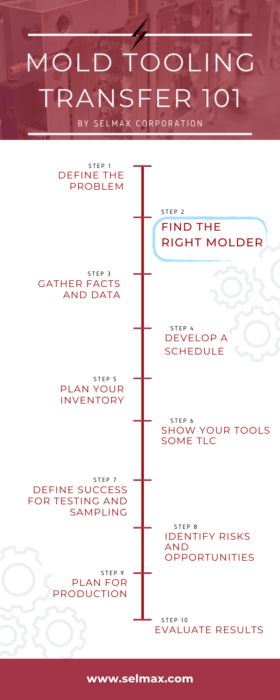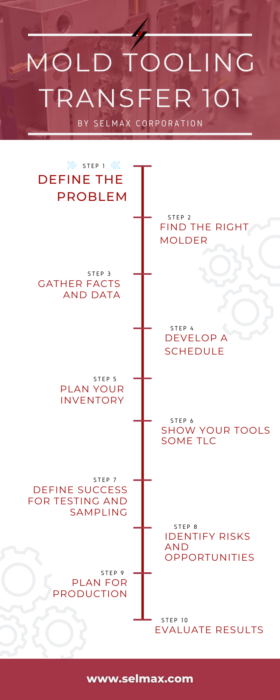Mold Tooling Transfer 101: Finding the Right Molder
4 Comments
After you’ve identified the problems and risks with your current supplier and decided you want to initiate a mold tooling transfer, it’s time to begin the search for a plastic injection molder that better aligns with your needs. Depending on your goals, some things may hold higher priority for you than others.
Here are some criteria to use that can help you quickly narrow down your search to find the right molder for your mold tooling transfer:
Machine Capabilities & Capacity
You’ll need to be sure that your new molder has the machine size and capacity available to handle your molds and the production volumes you’ll need to make each year. Be sure to provide prospective molders with your mold size, part size, and annual production numbers to set clear expectations from the start.
Industry Expertise
Another consideration for potential molders is their previous experience in your industry. This is especially important for industries, such as food/beverage, that require certain food-safe materials, or medical, that require special manufacturing considerations and certifications.
If the molder has not worked with your industry in the past, are they knowledgeable and capable of producing your parts to the standards you require?
In-House Tool Maintenance
Your new molder should have an in-house machine shop to properly care for and maintain your molds for the life of your project. If you’re transferring in molds with a lot of cycles on them, this will be especially important as they may need some TLC before they’re ready to run smoothly.
Material Sourcing and Handling
Does your prospective molder have a good relationship with high-quality raw materials suppliers? Are they able to get the exact materials you need in the quantities you need for your project? This is especially important in volatile times when the forces of supply and demand impact material availably and pricing. A good molder has built relationships with these suppliers over many years and may have an advantage in the marketplace.
Reputation and Experience
Be sure to check out your prospective molder’s reputation before committing to a tooling transfer. Ask them about their experience with mold tooling transfers in the past. Ask them to outline their process for transfers and what they do to mitigate risk and downtime.
Look for reviews on Google, check out their website, and find out how many years they’ve been in business.
Certifications
What certifications does the plastic injection molder have? Are they ISO 9001:2015 certified? You should also check to see if they’re members of industry associations, such as MAPP (Manufacturers Association for Plastic Processors).
Level of Support
Many molders may meet all your criteria for capacity, size, and manufacturing capabilities. However, it is also important to set an expectation for the level of support that will be provided throughout the life of your project.
Finding an injection molder that can work closely with you through each stage of the transfer process could be invaluable to your project. Having a seasoned consultant to help guide you through the process can save time and money and ensure that your mold transfer process is seamless.
Competitive Pricing
It’s important to ensure that your new molder has competitive pricing over the long run. However, the obvious prices, such as mold setup fees or part price are not the only way to determine the pricing structure. You should also look for hidden costs and risks that could end up amounting to more money over time.
For example, materials could be wasted producing low-quality parts, long lead times could interrupt your supply chain, or communication issues could result in parts that aren’t up to your standards.
Other Considerations
There are other things to take into consideration when choosing a new plastic injection molder for your project. Depending on the level of support you require, someone that is local or easily accessible may be important so you can meet in-person without too much hassle.
If your project requires after-ops processes such as assembly, sonic welding, or special packaging, these would all be important to discuss with your potential molder to be sure that they offer those services.
Another consideration is delivery requirements. If you have stringent delivery demands, it will be important to ensure that your chosen molder can meet or exceed your expectations. Make sure they’re well-established with trusted carriers and have the ability and experience to ship internationally, if needed.
Selmax Capabilities
With over 50 years of experience, Selmax Corporation takes great pride in meeting the most stringent material, color, and delivery requirements. Located in Selinsgrove, Pennsylvania, Selmax is within 4 hours of NYC, Philadelphia, Pittsburgh, Baltimore, and Washington D.C. and serves customers worldwide.
We offer services from concept to delivery, including design, 3D printing, mold making, production, assembly, packaging, and even short-term warehousing.
We also offer a high level of support throughout the process to make your mold transfer as seamless as possible.
Request a Quote to start the process today.
More in this series:
Step 3: Gathering Facts and Data
Step 5: Planning Your Inventory
Step 6: Showing Your Tools Some TLC
Step 7: Defining Success for Testing and Sampling
Step 8: Identifying Risks and Opportunities
Step 9: Planning for Production
Step 10: Evaluating Results
Mold Tooling Transfer 101: Defining the Problem
3 CommentsMold Tooling Transfer 101: Defining the Problem
With the events of 2020 exposing cracks and weaknesses in many supply chains, many companies are conducting mold tooling transfers to mitigate risk. If you have wondered if it’s time to transfer to a new supplier, maybe some of the following statements apply to you:
- I may need to establish a domestic supplier for my injection molding.
- I should probably move my injection mold tooling to a more stable supplier.
- My current injection molder may be a weak link in my supply chain.
- I feel like I’m just buying parts; not solutions to solve problems or take advantage of new opportunities.
- It seems like my business is no longer a priority to my injection molding supplier.
If you answered “Yes” to any of these, it may be time to look for a new injection molding supplier.
Transferring your injection mold tooling to a new supplier can seem like a daunting task. We will be breaking it down step-by-step over the next few weeks to help simplify the process.
Check Your Pulse
When considering a mold tooling transfer, it’s important to get a good understanding of your current situation. The following are some questions to consider:
→ What is the overall “health” of your current molder?
→ When was the last time you had a good status meeting with your molder?
→ Where are your tools?
→ Do you actually own the tools?
→ What condition are your tools in?
These are all important things to consider as you evaluate your current part production situation.
The location of your molder may be a risk in itself. In 2020, global supply chains felt the pain of the worldwide pandemic. Many businesses chose to bring their molds and production closer to home in order to keep their supply chains moving as smoothly as possible.
Assess Risks
If you are considering transferring your molds —especially from a molder in another country — there are some important things to keep in mind in the earliest stages of the process.
- Wait to tell your current molder of your plans to move the mold. Some molders may lose the incentive to act in your best interest after learning that they will be losing your business. It is better to have everything in place at the new supplier before notifying your current molder.
- Build inventory with your current molder. This will ensure you have enough inventory to keep up with sales throughout the transfer process.
- Gather information about the mold, such as the 3D files for the mold’s design, injection parameters, type of plastic used, and any other information that will be helpful for your new supplier to get your project set up and running smoothly.
Mold Tooling Transfers with Selmax
As a full-service plastic injection molder, Selmax stands ready to assist you in the process of sourcing your plastic injection molding in the United States.
We have manufactured millions of American-made products since 1971 and are proud to provide our customers with the high-level attention of a small operation and the quality and capability of a large-scale operation. Our turnkey manufacturing solutions include part design, mold design, mold making, high and low volume parts manufacturing, assembly, and delivery.
To learn more about transferring your mold tooling to Selmax, contact us today!

More in this series:
Step 2: Finding the Right Molder
Step 3: Gathering Facts and Data
Step 5: Planning Your Inventory
Step 6: Showing Your Tools Some TLC
Step 7: Defining Success for Testing and Sampling
Step 8: Identifying Risks and Opportunities
Step 9: Planning for Production
Step 10: Evaluating Results








